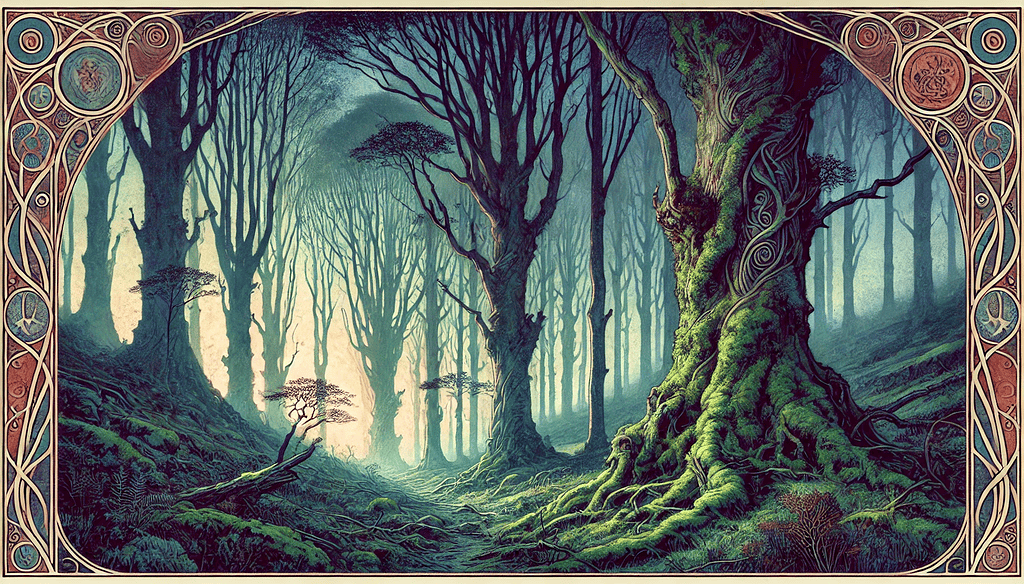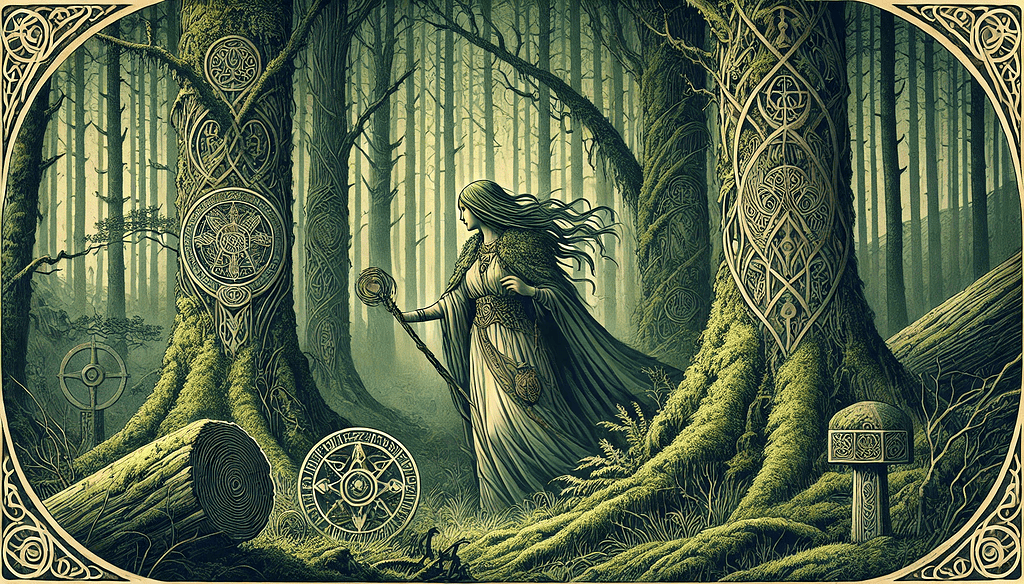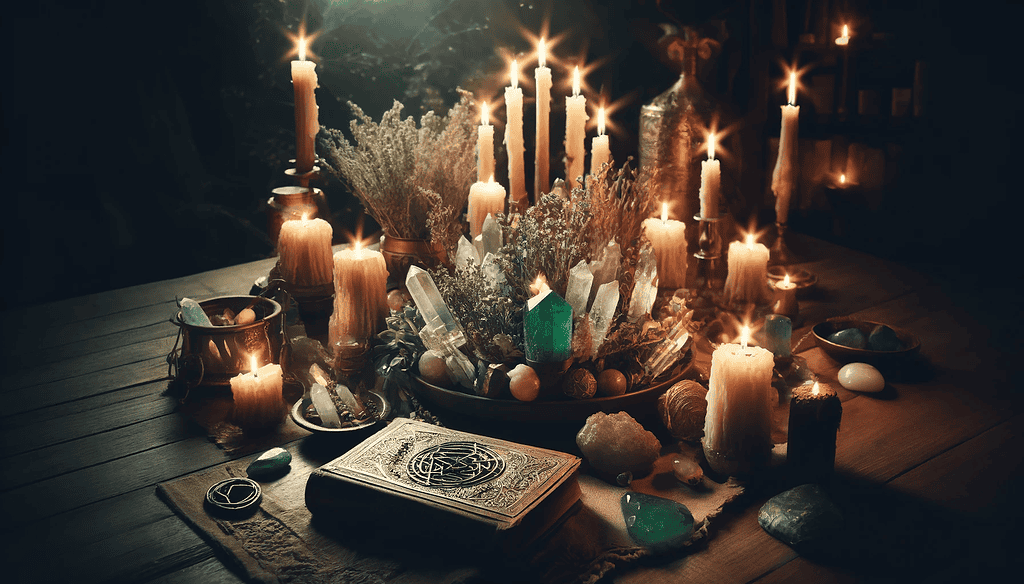No products in the cart.
August 19, 2024 10:28 am
August 19, 2024 10:28 am
Norse Paganism, based on the ancient pre-Christian traditions of Germanic peoples, still fascinates and inspires many people today.
This guide is designed for anyone interested in learning about Norse Paganism, whether you’re just curious or already have some knowledge.
In this guide, you will:
Now, let’s explore the captivating realm of Norse spirituality.

Norse Paganism has its roots in the ancient Germanic tribes that inhabited Northern Europe.
‘Norse’ hereby refers to a linguistic-cultural branch on the Indo-European tree-model.
Continental Germanic tribes who inhabited the areas today known as Germany, Denmark, Austria and likewise parts of the UK belong to the West-Germanic branch (Viking settlements not included).
The Norse belong to the tribes that evolved from Proto-Norse speaking tribes of what today is Denmark and southern Norway and Sweden.
These tribes shared a common language and culture, which eventually developed into what we now know as the Old Norse religion (Neil Price, 2002).
This belief system thrived in Scandinavia before the arrival of Christianity, covering present-day Norway, Sweden, Denmark, and Iceland.

For a long time, Norse Paganism was primarily passed down through oral traditions rather than being written down.
Skalds (poets) and storytellers played crucial roles in preserving myths, sagas, and poetic hymns.
When these stories were finally recorded, they were found in important texts like the Poetic Edda and the Prose Edda.
These texts are essential for understanding the old beliefs and practices.
The arrival of Christianity had a significant effect on Norse Paganism. From the 8th to the 12th centuries, Christian missionaries began converting Scandinavian societies.
This resulted in a blending of Christian elements with traditional Norse beliefs. For example:
Despite these changes, many core aspects of the old ways remained, subtly influencing contemporary Scandinavian culture.
Understanding the historical background of Norse Paganism deepens our appreciation for its lasting impact on modern spirituality.

Modern Norse Paganism has seen a significant resurgence in recent decades.
This revival is partly driven by a growing interest in ancient traditions and a desire to reconnect with the spiritual practices of pre-Christian Europe.
Many people find the rich mythology, vibrant rituals, and deep connection to nature offered by Norse Paganism appealing.
Norse Paganism isn’t a monolithic tradition; instead, it’s a diverse tapestry of beliefs and practices. Here are some of the most notable paths:
Ásatrú’s official recognition in Iceland marked a significant milestone for modern Norse Paganism.
In 1973, the Icelandic government granted Ásatrú legal status as a religious organization.
This recognition not only legitimized the faith but also helped foster a sense of community among its followers.
Modern Norse Paganism continues to evolve, with each path offering unique perspectives on ancient traditions.
Whether you are drawn to the Aesir gods, the Vanir deities, or the enigmatic giants, there’s a place for you within this rich spiritual landscape.

Norse Paganism is a polytheistic religion, meaning it embraces the worship of multiple deities.
The pantheon is primarily divided into two groups: the Aesir and the Vanir.
Beliefs and practices of Norse religion are deeply rooted in an animistic worldview. In this perspective:
The animistic beliefs create a sense of interconnectedness between humans and their environment, emphasizing respect for natural elements.

Fate plays a crucial role in Norse cosmology.
The Norns—three powerful female beings named Urd (Past), Verdandi (Present), and Skuld (Future)—weave the threads of destiny for all beings.
These figures reside by Yggdrasil, the World Tree, influencing the lives of gods and humans alike.
Unlike some belief systems where fate might be seen as absolute, Norse mythology portrays it as a complex web where even divine beings have limited control over their destinies.
Understanding these core beliefs helps you appreciate how ancient Norse pagans viewed their world—a realm rich with divine presence, ancestral importance, and an intricate tapestry of fate woven by the enigmatic Norns.

The sacred texts of Norse religion serve as crucial pillars for understanding the beliefs, values, and practices of ancient Norse society.
These texts continue to inspire and guide modern practitioners of Norse Paganism.
The Hávamál is a collection of Old Norse poems from the Poetic Edda, offering wisdom attributed to Odin himself.
It covers a wide range of topics, including ethics, wisdom, and practical advice for daily living.
The text remains a cornerstone for those seeking to live by the virtues and principles revered by ancient Norse cultures.
The Poetic Edda, also known as the Elder Edda, is a compilation of mythological and heroic poems.
Key stories such as the creation of the world, Ragnarok (the end times), and tales of gods like Thor and Loki are found here. Notable sections include Völuspá (The Prophecy of the Seeress) and Grímnismál (The Sayings of Grímnir).
These narratives provide profound insights into the cosmology and deities worshiped by Norse Pagans.

Written by Snorri Sturluson in the 13th century, the Prose Edda serves as both a manual for aspiring poets and a repository of Norse myths.
It includes detailed accounts of gods, giants, and cosmological events.
The work is invaluable for its systematic presentation of mythological stories.
Icelandic sagas are prose histories that document the lives and exploits of early Icelanders, blending historical facts with mythological elements.
Works such as Egil’s Saga, Laxdæla Saga, and Njáls Saga offer rich narratives that preserve folklore, cultural values, and societal norms.
“These sagas not only recount heroic deeds but also capture everyday life in medieval Iceland. They are essential for understanding how mythology interweaves with history.”
Skaldic poetry is another significant literary form from this era, characterized by its complex meter and kennings (metaphorical expressions).
Unlike the more straightforward style found in the Eddas, skaldic verses are intricate and often require deep knowledge to interpret fully.
These poems praise gods, heroes, and chieftains while preserving oral traditions through their elaborate structure.
Ancient texts like these shape modern practices within Norse Paganism by providing a rich tapestry of stories and teachings that continue to resonate today.

Norse Paganism is rich with rituals and traditions that connect you deeply with the ancient ways of life.
These practices serve as a bridge to the past, engaging you in meaningful acts that honor deities, the natural world, and community bonds.
Seasonal Festivals: Celebrating the cycles of nature is central to Norse Pagan practice. Blóts (sacrifices) are held during key seasonal changes:
Rites of Passage: Significant life events are marked by specific rituals:
Feasts play a pivotal role in Norse Paganism. They are not just about eating but involve storytelling, singing, and reinforcing social bonds.
These gatherings often coincide with seasonal festivals or significant communal events.
The significance of these feasts cannot be overstated:
An intriguing aspect of Norse Paganism is seiðr magic—a form of shamanistic practice (not to be confused with traditional North Eurasian shamanism!) involving trance states to gain insights or influence outcomes:
Through these rituals and traditions, not only do you connect with your ancestors but also foster a sense of community that transcends time.

Embarking on the path of Norse Paganism is a deeply personal and unique journey. There is no single, fixed way to become a Norse Pagan, making your exploration both exciting and rewarding.
Your first step is to embrace the idea that there isn’t a strict rule book.
Norse Paganism thrives on individual discovery and interpretation, as well as in-depth ethnographic and historical study of the cultures and regions in northern Europe.
Begin by immersing yourself in the rich tapestry of myths, legends, and histories that form the bedrock of this spiritual tradition.
To guide you through the initial stages, consider these practical steps:
By following these steps, you’ll not only learn about Norse Paganism but also cultivate a meaningful connection with its rich spiritual heritage.

To deepen your understanding of Norse mythology and history, here are some valuable resources to guide your journey:
For those who prefer digital resources, several classic texts are available online for free:
Other notable mentions include:
These texts provide a rich tapestry of knowledge that will enrich your understanding and appreciation of Norse Paganism.

Norse mythology has undeniably captured the imagination of filmmakers, animators, and writers.
This enduring fascination has led to an array of movies and TV shows related to Norse mythology that have brought ancient stories into contemporary entertainment.
These representations not only entertain but also serve as gateways for deeper exploration into Norse mythology. Whether you’re drawn to the intense action or the rich storytelling, these media portrayals keep the spirit of Norse legends alive in modern culture.
Starting your journey into Norse Paganism opens up a world rich with ancient wisdom and vibrant spirituality.
Embrace the diversity within this faith, as there is no singular path to follow.
Each person’s exploration is unique, contributing to a broader understanding of the old ways.
“The paths are many, but the spirit is one.”
Ancient beliefs offer profound insights into modern life.
The reverence for nature, the value of community, and the acceptance of life’s cycles resonate deeply today.
Incorporate these timeless principles into your daily existence to forge a meaningful connection with the past.
Norse Paganism is not just about worship; it’s about embodying a worldview that’s as relevant now as it was centuries ago. Keep exploring, learning, and growing—your journey has only just begun.
References and further reading:
Harvey, Graham and Hardman, Charlotte eds. (1996). Paganism Today: Witches, Druids, the Goddess and Ancient Earth Traditions for the Twenty-First Century. London: Thorsons.
James R. Lewis et al. Handbook of Contemporary Paganism. (2009). Netherlands: Brill.
Price, Neil S. (2002). “The Viking Way : Religion and War in Late Iron Age Scandinavia.” dissertation, Uppsala: Dept. of Archaeology and Ancient History.